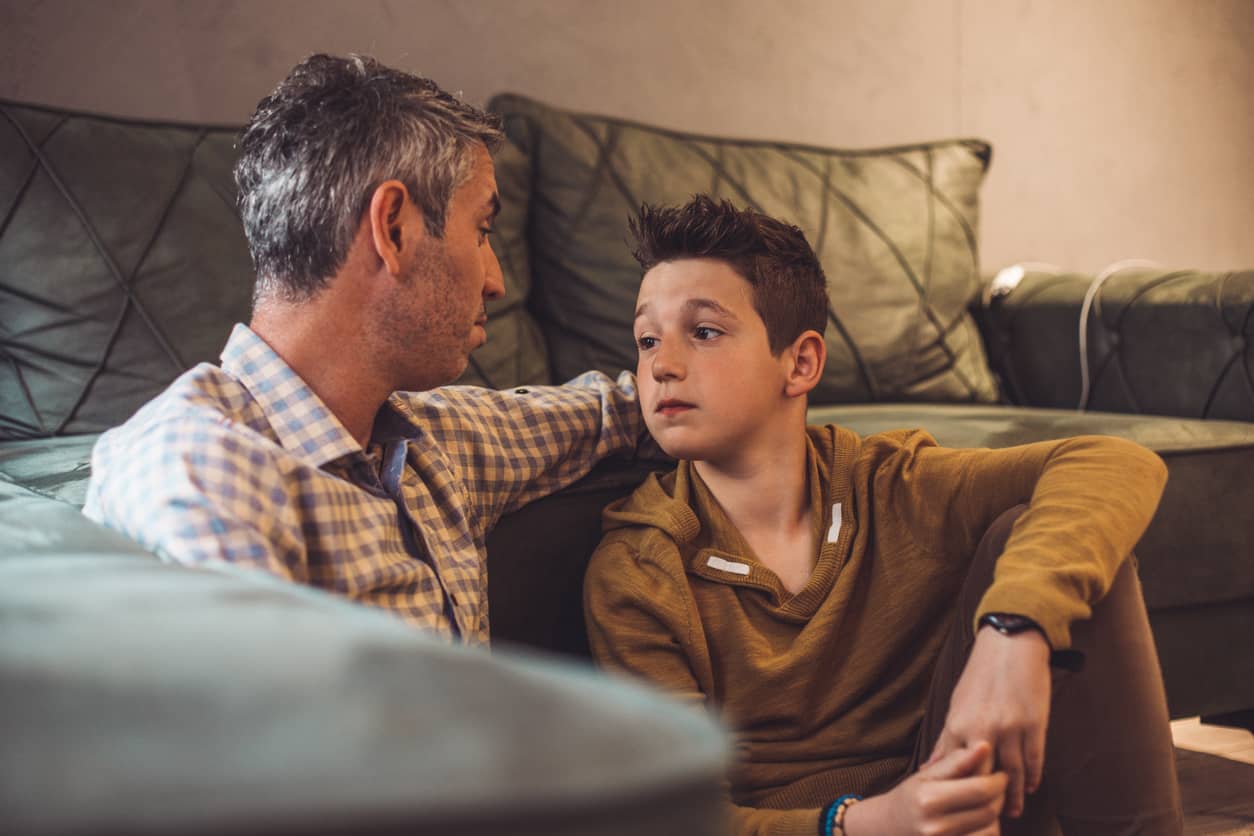Empathy is not one-size-fits-all. Different types of empathy are appropriate for different people, relationships, and circumstances.
If you are struggling to express empathy, your problem might not be that you aren't an empathetic person—it could be that you're accessing a type of empathy that doesn't come naturally to you or that the type of empathy you're expressing isn't appropriate for the situation at hand.
Estimated reading time: 6 minutes
 The Roots of Empathy
The Roots of Empathy
As humans, whether it comes naturally to us or not, the capacity to be empathetic is a part of being human. The ability to express empathy is programmed in our DNA.
Empathy is one of our most basic animal instincts. We have all observed how our pets seem to feel our pain when we are sad or recoil in fear when we are angry. That's because we share this power of empathy with other mammals.
In fact, much of what we know about empathy, we learned from our primate cousins. Studies of rhesus monkeys have traced our penchant for empathy back to mirror neurons. These special brain cells lead us to mimic the emotions and behaviors of those around us.
Of course, human empathy has since evolved to become more sophisticated. Our definition of empathy now encompasses multiple types of empathy, including emotional, cognitive, and compassionate.
Let's talk about the three types of empathy and how and when to use them for the best results.

Why Do We Need Different Kinds of Empathy?
Empathy is important for a number of reasons. It allows us to feel heard and understood, which are basic human needs that deeply impact how we relate to one another.
But, the type of empathy we express matters, too, because that choice can create connections (or disconnections) between ourselves and others. Without empathy in our relationships (or using the most effective kind of empathy), we can struggle to form meaningful and lasting relationships, whether they are platonic or romantic.
For example, we've all experienced how our attempts to comfort someone can go awry unexpectedly. Even when we think we're doing or saying the right thing, we sometimes get a reaction that's not what we wanted or expected.
In these situations, we may be unaware that we're asserting a disheartening approach. For instance, we might be trying to solve a close friend's problem when all they want is someone to truly listen. Or we might be attempting to make a customer calm down by resolving an issue when acknowledging and empathizing with their frustration and dissatisfaction are imperative to help them calm. We can move too quickly to solve their predicament and forget that emotions need to be expressed and understood.
 When you receive an unexpected reaction to your attempts to be empathetic, it’s a clue that you might need to apply a different type of empathy for that situation or you’re solving the person’s problem instead of empathizing.
When you receive an unexpected reaction to your attempts to be empathetic, it’s a clue that you might need to apply a different type of empathy for that situation or you’re solving the person’s problem instead of empathizing.
When this happens, it's important to turn inward and ask ourselves where we’re coming from and if the type of empathy we're using is helping or hindering the person from feeling heard. How is our response affecting the situation? When a person feels emotionally heard and understood, the intensity of their emotion diminishes—a second cue we’re utilizing the most effective kind of empathy.
The Different Kinds of Empathy Applied
The three types of empathy—emotional, cognitive, and compassionate—are appropriate for different roles, relationships, and situations. Let’s take a closer look at the most effective use of each.
Emotional Empathy
Emotional empathy is sensing the pain or emotions of another person. While emotional empathy can be helpful for "walking in another person's shoes" and understanding their emotions on a deep level, it can also become unwieldly or overwhelming in the wrong context, especially if we’re uncomfortable with that particular emotion.
Deeply sensing the emotions of others might be appropriate in our personal relationships, but it’s not always appropriate at work or school. Emotional empathy can elicit a strong emotional response in us that impacts our actions as well as our feelings.
Particularly in group situations, navigating multiple feelings can make it more difficult to stay balanced and centered in a caring and helpful stance. We can even have knee-jerk reactions that cause us to express ourselves in unsuitable ways. So, in these situations, cognitive empathy is more helpful,
Deep dive: The Three Types of Empathy Explained, Part I: Emotional Empathy
 Cognitive Empathy
Cognitive Empathy
Cognitive empathy relies on the help of our intellect. We can relate to what the person might be thinking or feeling, although we aren't necessarily engaging at an emotional level. Because of its reliance on logic, cognitive empathy is helpful for work relationships and better suited for group situations.
On the flip side, cognitive empathy can sometimes be interpreted as uncaring or distant when someone is seeking deep and meaningful emotional connections. Cognitive empathy is about understanding intellectually what a person might be feeling so it maintains a level of emotional distance. This form of empathy is well-suited between a leader and employee or between a doctor and patient since it restrains the emotional connection from forming deep friendships or romantic ties.
A common example of cognitive empathy gone awry is when a friend or romantic partner responds to your emotions with cold objectivity. In personal relationships, we often want an emotional connection and closeness reached through a heart-to-heart resonance. However, cognitive empathy is a mountain view of others' emotions with objectivity and impartiality, which is very valuable in the right roles and circumstances.
Deep dive: The Three Types of Empathy Explained, Part II: Cognitive Empathy
Compassionate Empathy
Compassionate empathy is the most viscerally compelling type of empathy. It not only helps us understand another person's perspective and emotions but also moves us to take action to help another person. Compassionate empathy can be applied to a broad spectrum of situations. This type of empathy imparts a balanced and deep caring while partnering with the person in their experience. It also carves a clear path to resolution.
Compassionate empathy especially nurtures emotional connections and close interpersonal relationships; it takes a "whole person" approach that utilizes multiple types of empathy to understand and reflect back what another person is feeling. When people feel heard and understood by us, it creates deep, meaningful bonds—bonds that, if we're fortunate, might last a lifetime.

Compassionate empathy (also referred to it as compassion) can be thought of as a combination of cognitive and emotional empathy. It draws on both logic and emotion to generate a loving, compassionate response. By honoring this natural connection between the brain and the heart, you're able to respond to another person's emotions in a thoughtful and meaningful way.
Deep dive: The Three Types of Empathy Explained, Part III: Compassionate Empathy
How to Develop Empathy
Science shows us that we can learn to be empathetic, but like any muscle, empathy needs to be exercised to strengthen it. Thankfully, empathy can be both learned and taught.
The process of learning to understand our own and another person's emotions is known as emotional literacy. This includes naming our emotions, identifying the physical sensations and behaviors associated with those emotions, and reflecting others' emotions back to them.
One way we often disrupt understanding and the development of emotional literacy is by using feeling-stoppers. These phrases minimize or deny the impact of our emotional landscape. By saying "I'm fine” when you're really not, or telling someone else, "you don't really mean it," you're invalidating their emotions. Feeling our feelings, even the uncomfortable ones, helps them pass more quickly—and helps us access those feelings in situations that require our emotional and compassionate empathy.
If you're looking to self-teach yourself to become a more empathetic person, our self-coaching workbook Real Empathy, Real Solutions is a great place to start. Once you master the basics of empathy, you can teach yourself to access the three different types of empathy.
Developing your empathy also includes learning to choose which type of empathy to use in what situation. The ideal approach is to fluidly switch between types of empathy as needed, which requires basic skills developed in Real Empathy, Real Solutions.
Those skills include accessing your emotions and the emotions of others and recognizing the nuances inherent in every situation. In the next section, we'll learn about a free tool you can use to strengthen all three types of empathy: an empathy map.
What Is an Empathy Map?
An empathy map is a diagram to help you visualize the complexity of and interconnected parts that work together to create our emotional responses. It requires you to ask yourself four questions:
- How does this person THINK?
- How does this person FEEL?
- What does this person SAY?
- What does this person DO?

All of these parts work together to create our emotional experience, which is why the person lies at the center of the map: you are the center of your emotional world!
You can use this map to help you access the thoughts, feelings, and actions of another person. It might feel a little silly at first, but by exercising your empathy, you'll be able to strengthen the skill over time. Once a skill is practiced repeatedly, integration takes place. Then we are free to personalize the skill to represent us more accurately. With emotional mastery, each person’s uniqueness creates an original style of empathy.
Real Empathy, Real Solutions
You now see how empathy is not a one-size-fits-all approach. Understanding the nuances of our emotions and selecting the appropriate form of empathy for the situation at hand is critical to developing our emotional intelligence.
You’ve begun learning how to develop and access all three types of empathy. If you would like an empathy check-up to be sure you have this vital skill honed, check out our popular digital workbook, "Real Empathy, Real Solutions: 4 Keys for Unlocking the Power of Empathy!










